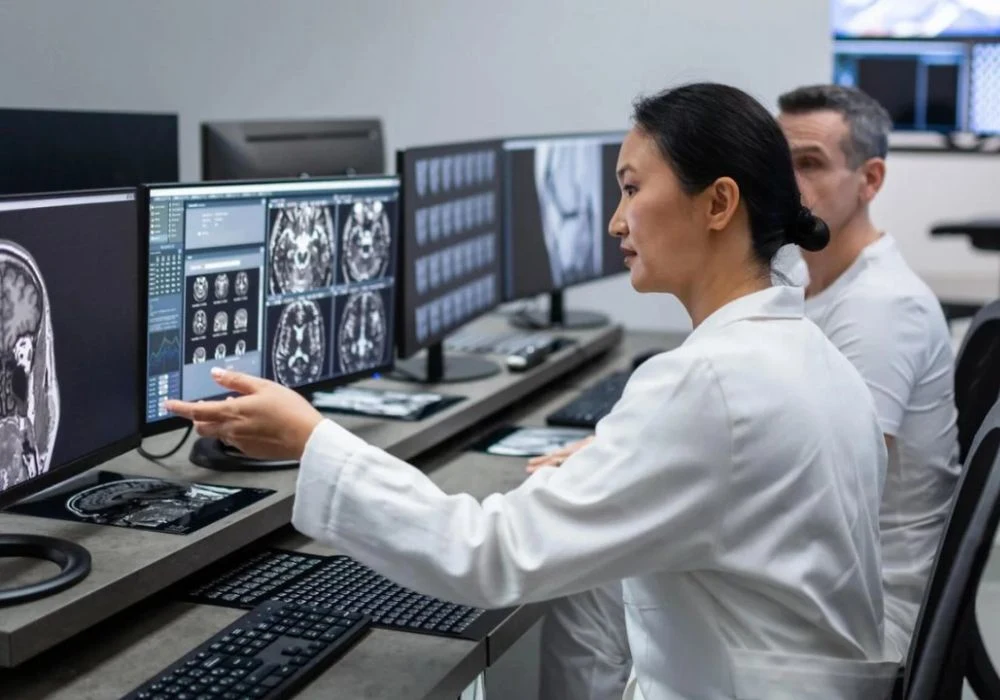Magnetic resonance imaging (MRI) underpins routine neuroimaging, but lengthy acquisitions can challenge patient comfort, increase motion artefacts and slow clinical workflow. Deep learning (DL) reconstruction has emerged to accelerate image acquisition while aiming to maintain diagnostic performance. A single-centre retrospective comparison evaluated DL-derived MRI (DL-MRI) against conventional MRI (C-MRI) across routine neuroradiologic examinations performed on a 3 T scanner between 24 October and 14 November 2023. The analysis encompassed 26 patients and 113 paired sequences spanning brain, spine and head and neck indications. Four neuroradiologists, blinded to acquisition method, compared paired sequences on image quality using a 5-point Likert scale, and acquisition parameters were extracted from DICOM metadata. The findings describe acquisition efficiency, reader preference and sequence-specific patterns relevant to everyday protocols.
Substantial Time Savings Across Routine Examinations
DL-MRI achieved a marked reduction in acquisition time. Mean scan duration fell by 51.6% from 110.84 seconds to 53.65 seconds with statistical significance, underpinned by higher parallel acceleration and fewer averages in DL-MRI relative to C-MRI. Specifically, the mean acceleration factor was 3.58 for DL-MRI compared with 1.54 for C-MRI, and the mean number of averages was 1.11 versus 1.88. No other parameter differences reached significance after correction. The magnitude of time saving exceeded the minimum detectable effect size determined in the power analysis.
Efficiency gains were not uniform across all orientations and anatomical targets. Sequences evaluating the sella showed the most pronounced reduction in time, and coronal acquisitions demonstrated greater decreases than sagittal and axial planes. The sampling strategy emphasised 2D turbo spin echo acquisitions, allowing a like-for-like comparison focused on the impact of reconstruction rather than wholesale protocol changes. Across the cohort, brain examinations constituted the largest share of pairs, followed by cervical, thoracic and lumbar spine, reflecting typical neuroradiology case mix in a tertiary setting.
Must Read: Expanding MRI Access with Mid-Field and 1.5-T Systems
The patient sample had a mean age of 54.5 years with a predominance of women. Sequence distribution covered T2-weighted, T1-weighted, short tau inversion recovery (STIR), post-contrast T1, T2 fluid-attenuated inversion recovery (FLAIR) and proton density. Axial and sagittal orientations were most common, with a smaller proportion of coronal sequences. These characteristics provide context for interpreting time reductions that were consistent at the aggregate level yet varied by sequence type, plane and target region.
Image Quality and Reader Preference
Reader assessments modestly favoured DL-MRI on several quality dimensions while indicating no meaningful difference for artefacts. On the 5-point scale, where 3 denoted no preference, average ratings were 3.56 for overall preference, 3.51 for perceived signal-to-noise ratio, 3.50 for structural delineation and 3.33 for diagnostic quality. For artefacts, the mean rating was 3.06 with a 95% confidence interval of 3.00–3.13, indicating no significant preference between methods. Effect sizes were large for significant parameters except artefacts.
Despite these shifts, interrater reliability was low across all assessed parameters, with intraclass correlation coefficients ranging from 0.064 to 0.329. Reliability was highest for overall preference and signal-to-noise and lowest for tissue-specific characterisation such as muscle and fat. The clustering of ratings near the neutral value contributed to low agreement and suggests functional equivalence between DL-MRI and C-MRI for routine assessments at the sequence level. Familiarity with DL-MRI capabilities, the presence of distinct artefact signatures and subjective emphasis on sharpness may also have influenced reader judgements.
Qualitative comments highlighted structure-specific impressions. The central vein sign on axial T2 fat-saturated images and the posterior median spinal vein on sagittal post-contrast T1 images were described as well visualised with DL-MRI. Conversely, grey–white matter differentiation on axial T1-weighted brain images was noted as less conspicuous with DL-MRI. These observations did not translate into a systematic preference shift for artefacts or diagnostic quality at the cohort level but may inform protocol nuances where specific structures are of interest.
Sequence-Level Patterns and Artefact Characteristics
Sequence-level analysis of commonly sampled pairs underscored differences in perceived performance. Cervical axial T2 and brain axial T2 were the highest-performing sequences, coupling substantial time reductions with higher reader preference. Cervical axial T2 achieved a mean reduction of 87.3 seconds, equivalent to 67.3%, alongside an overall preference mean of 3.81. Brain axial T2 delivered a 46.0-second reduction, or 47.9%, and the highest overall preference mean of 3.89. Brain sagittal T1 also showed balanced gains, with a 51.0-second reduction and preference above neutrality.
At the lower end, thoracic sagittal STIR exhibited a moderate time reduction of 48.7 seconds, or 47.1%, but a lower overall preference mean of 3.12. Across sequence categories, T2-weighted acquisitions, particularly in the axial plane, tended to outperform others in preference metrics, whereas STIR sequences achieved time savings with more modest preference. A statistical comparison between the best and lowest performers indicated a significant difference in preference, suggesting that the benefits of DL-MRI can vary by sequence type and anatomical region.
Distinct artefact patterns were observed with DL-MRI, especially in spinal imaging. Raters noted increased conspicuity of cerebrospinal fluid pulsation artefact on sagittal T2 sequences, vertical banding in the phase-encoding direction and more prominent Gibbs ringing at the cerebrospinal fluid–cord interface. On some sequences the cord appeared grainier. Some DL-MRI sequences were also described as showing slightly more motion. Despite these signatures, artefact ratings overall did not favour one method, and the frequency of specific artefacts was not quantified in this evaluation.
The discussion raised practical considerations for protocol design. Given the aggregate time savings and broadly similar perceived quality, a hybrid approach has been considered at the evaluating centre, for example using DL-MRI for T2-weighted sequences and retaining conventional acquisition for STIR where reader preference was lower. Any such approach would benefit from larger, balanced datasets that can clarify sequence-specific trade-offs and define optimal configurations across vendors, field strengths and reconstruction algorithms.
Across routine neuroradiologic examinations in a tertiary setting, DL-MRI reduced acquisition time by 51.6% while maintaining image quality comparable to C-MRI based on blinded reader assessments with low interrater reliability. Efficiency gains reflected higher acceleration and fewer averages and were most pronounced in selected targets and planes. Sequence-level patterns, structure-specific observations and distinctive artefact signatures offer practical insights for protocol refinement, while the overall equivalence supports integration without compromising diagnostic aims. Validation in larger, multi-centre cohorts using diverse platforms would help determine where DL-MRI provides the greatest benefit and how hybrid strategies can balance speed, consistency and clinical priorities.
Source: Radiology Advances
Image Credit: iStock










